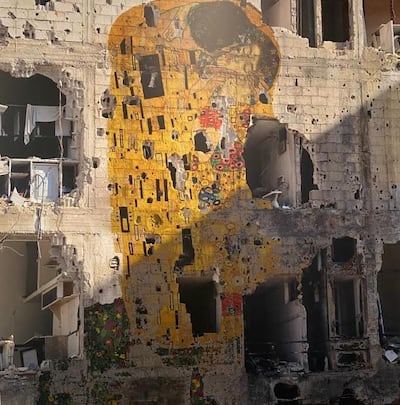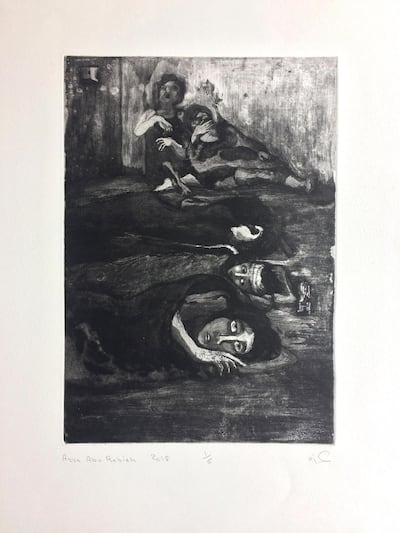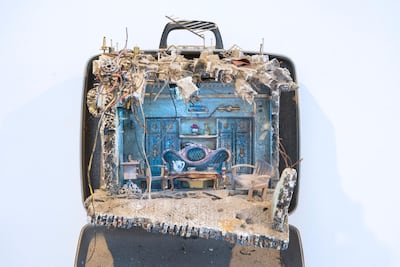In 2013, artist Tammam Azzam superimposed an image of Gustav Klimt's The Kiss on to the facade of a bombed-out building in Syria. The contrast of the couple embracing against a luxurious golden background, and the pockmarked structure it was overlaid on to, made for an immediately famous image. Many thought that the graffiti was real, and the image continues to circulate, popping up on Twitter from time to time.
But the work was made on Photoshop from Dubai, where Azzam had fled to after leaving Damascus. Rather than being an intervention into a war-torn city, it spoke of that other effect of conflict: exile.

Freedom Graffiti reappears now in the show In this Moonless Black Night: Syrian Art After the Uprising, at the Middle East Institute in Washington, US. The exhibition of 12 Syrian artists is curated by the art historian Maymanah Farhat, who worked at Damascus's Ayyam Gallery in the mid-2000s and again in the mid-2010s.
The arrival of Ayyam in 2006 was a crucial moment. After decades of economic and political isolation, Syria’s art scene was then just taking off, and Ayyam and its incubator programme allowed artists the opportunity to concentrate on their work. (Two years after opening in Damascus, Ayyam expanded to Dubai and was the first to set up shop in what became Alserkal Avenue.)
“I grew up with many of these artists, professionally,” says Farhat. “I would go and sit in their studios, and we’d have coffee, and everyone’s smoking cigarettes, and they’re talking dialectics, and aesthetics, and philosophy and all these sort of things. They were so gracious – so sweet and very generous with their knowledge.”

In This Moonless Black Night has the feel of a homecoming, digitally experienced, from the perspective of someone who knows it could have gone differently for these artists. Instead of being a snapshot of Syrian art, it becomes a snapshot of how Syrian art was affected by conflict and exile.
In Goya-esque etchings, Azza Abo Rebieh represents her internment in Adra prison in Damascus, where she was detained for 70 days because of her activism against the regime. After she was released she drew the women and the situations she encountered to honour their memory.
Here, etchings evoke the conditions she endured, such as In One 3 Meter-Square Room, We Were Fifteen Women (2018), or one that referred to a hunger strike that many of the artists went on, Why Do Not They Give Her Epilepsy Medicine? You Are Out of Time (2018), when they refused all food and medicine.

Mohamad Hafez shows his diorama-like suitcases, which are opened as if in explosion, with dust blanketing the minute domestic scenes conjured inside. The references to destruction and exile are clear but the scale keeps them from being mawkish, as they lean firmly towards intimacy and fragility.
Other artists focus on the conditions of displacement, such as Khaled Barakeh's reworked "EXIT" sign that reads "EXILE", or I Haven't Slept for Centuries, in which he compiles all his passport visas, checkpoints stamps and denials on to a single canvas, where the sheer number of them renders the whole work illegible. Osama Esid shows images from refugee camps, where tents were outfitted to look more like Syrian homes.

The artists' practices were also affected by the change in access to materials, as they left their studios behind. Some, like Azzam, began working digitally, in Photoshopped collages. Others continued the activism they had begun in Damascus, creating images that could easily travel and inspire others.
“What’s interesting about Syria is that due to technology, there was an immediate exchange that took place among artists” once protests against Bashar Al Assad started, says Farhat.
“There were already artists who were living abroad, in Paris and Berlin, and in Beirut and other parts of the Arab world. And so there was a really rapid exchange among the artists that supported the uprising and the resistance. They immediately took to their computers, and started creating content.
“As war unfolded, the situation completely changed,” she continues. “A lot more artists reflected on the fact that a huge humanitarian crisis was taking place, especially with the refugee crisis.”
Though technology is not an exclusive interest of the show, the interconnectedness of the Syrian artists during their Civil War – as opposed to the isolation of many artists during the Lebanese Civil War, for example – provides a suggestive counterpoint to MoMa PS1’s Theatre of Operations: The Gulf Wars 1991-2011 (2019-2020).
That show, which zeroed in on the Iraq conflicts, showed how technology mediated the war in Iraq for American audiences and artists. In This Moonless Black Night gestures towards the opposite: the way that Syrian artists were affected by the awareness of what was going on back home.
In this sense, the show is a stark reminder of the work that needs to be done to research Syrian contemporary art and its response to the war.
Part of the problem is that the conflict is ongoing. Government surveillance of the art sector, even internationally, remains high, and Farhat and the Middle East Institute had to tread carefully so that no artists or their families were jeopardised by being in this exhibition.
The title of the show is carefully chosen: it comes from a poem by the late Syrian poet Da’ad Haddad, and reminds us that war is not over yet.
“One of the main points of the show, especially being in Washington, DC, is to highlight the resilience of the artists,” says Farhat.
“I’m forever taken by it. Being Lebanese, and understanding the experience of uncertainty and loss and destruction, I’m always amazed by them.
“I really wanted to communicate that in the show: that these are artists who have been committed not only to their artistic practices and furthering their own individual aesthetics, but also to the Syrian people, and the long-standing culture and artistic heritage that they have.”
In This Moonless Black Night: Syrian Art after the Uprising runs until July 16, at the MEI art gallery in Washington, DC


